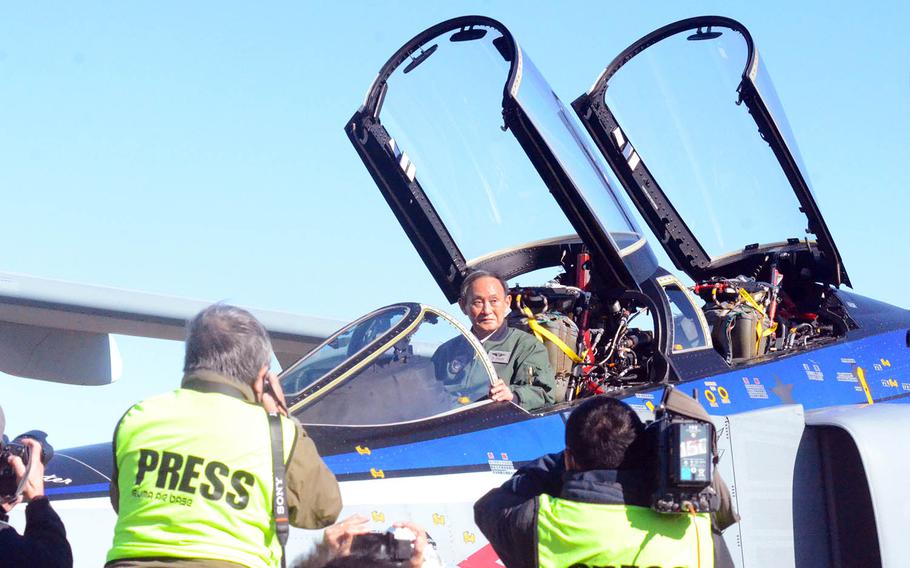
Japanese Prime Minister Yoshihide Suga poses in an F-4EJ "Samurai" Phantom II fighter jet at Iruma Air Base, Japan, Saturday, Nov. 28, 2020. (Seth Robson/Stars and Stripes)
IRUMA AIR BASE, Japan – Japan’s iconic F-4EJ “Samurai” Phantom II supersonic fighter jet was sent off in style Saturday during a Japan Air Self-Defense Force review near Tokyo.
One of Japan’s last Phantoms, painted with sharp-toothed, snarling nose art, red sun symbols and the words “Phantom Forever” greeted Japanese Prime Minister Suga Yoshihide Suga at Iruma Air Base in Saitama prefecture when he arrived to speak to about 800 troops.
Suga warned the air, ground and maritime defense personnel of an increasingly severe security environment and urged the service branches to cooperate before he clambered into the F-4’s front seat and posed for photos.
A week earlier, on Nov. 20, the 301st Tactical Fighter Squadron at Hyakuri Air Base, Ibaraki prefecture, held a send-off ceremony for its Phantoms. The 301st is slated to move from Hyakuri to Misawa Air Base in northeast Japan in March and trade its F-4s for state-of-the-art F-35A Lightning II stealth fighters.
Japan is retiring the F-4s after 48 years of service, according to a JASDF tweet that day.
Japan chose the large, twin-engine, two-seat multirole F-4 as its next-generation fighter on Nov. 1, 1968, and eventually acquired 140, according to the JASDF’s official website.
The 301st was the first squadron to operate the F-4EJ at Hyakuri in October 1973. The Japanese Phantom fired its first warning shot near a Soviet Tu-16 strategic bomber intruding into Japanese airspace during a scramble on Dec. 9, 1987, according to the JASDF website.
The McDonnell Douglas-built F-4 was designed in the 1950s for air-to-air and air-to-ground missions. Eventually, 5,195 were built for the U.S. Air Force, Navy and Marine Corps as well as 11 foreign militaries, including Japan.
The F-4 became the most famous American fighter-bomber of the 1960s and 1970s, epitomizing U.S. air power during the Cold War and used extensively in Vietnam.
With a top speed exceeding Mach 2.2, the supersonic fighter-bomber is remembered fondly by those who flew it.
The F-4 was, “in the hands of a talented pilot and weapons systems operator ... formidable and nearly indestructible,” retired Air Force Gen. Ronald Keys, who flew Phantoms in the Vietnam War, told Stars and Stripes for a Nov. 10, 2019, story.
Soviet-built MiG-21s were the Phantoms’ main foe throughout the Cold War. Compared to the diminutive MiG, which could carry 4,400 pounds of ordnance, the Phantom was able to load a whopping 18,000 pounds of munitions, including bombs, air-to-ground and air-to-air missiles, on nine underwing hardpoints.
One of the more flattering nicknames given to the Phantom over the years was “the world’s leading distributor of MiG parts.”
The Phantom was officially retired from squadron duty in the U.S. in 1996, five years after it flew combat missions against air-defense missile batteries in Iraq during Operation Desert Storm.
Japan will retire its last F-4EJs by the end of the year. The country is buying 150 F-35s, including the short takeoff, vertical landing F-35B, which will operate from the nation’s first postwar aircraft carriers, the Izumo and Kaga.
Stars and Stripes reporter Hana Kusumoto contributed to this report.
robson.seth@stripes.com Twitter: @SethRobson1